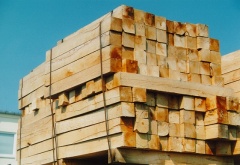Timber
| Infobox on Timber | |
|---|---|
| Example of Timber |  |
| Facts | |
| Origin | This table shows only a selection of the most important countries of origin and should not be thought of as exhaustive.
|
| Stowage factor (in m3/t) | See text |
| Humidity / moisture |
|
| Ventilation | If the product is dry for shipment, ventilation is not normally required. However, if there is a risk of drying or moisture damage, ventilation should be provided. The following ventilation measure is then recommended: air exchange rate: 6 changes/hour (airing) |
| Risk factors | Mechanical damage(s) may occur (see text). |
Timber
Contents
Description
Lumber (also known as Timber) is supplied either rough or finished. Besides pulpwood, rough lumber is the raw material for furniture-making and other items requiring additional cutting and shaping. It is available in many species, usually hardwoods. Finished lumber is supplied in standard sizes, mostly for the construction industry, primarily softwood from coniferous species including pine, fir and spruce (collectively known as Spruce-pine-fir), cedar, and hemlock, but also some hardwood, for high-grade flooring.
Commercial timbers fall into two main categories, softwoods and hardwoods. The distinction is botanical and does not indicate hardness, e.g. Balsa is a hardwood. As a generalization, softwoods are coniferous (evergreen) and hardwoods are deciduous (broad leafed). There are exceptions. After conversion by sawing to useable sized, it is necessary to remove the inherent moisture (seasoning). This makes the timber more stable, resistant to decay and insect attack, lighter, stronger and easier to work and finish.
Moisture content over approximately 21% and lack of ventilation can lead to mould and fungal growth, which can result in permanent staining and decay. Drying timber is effected by stacking and separation of the tiers of pieces with dry square sticks to allow ventilation by ambient air or heated air in a kiln. Timber which has become wetted in transit should be dried by similar methods. Shrinkage, twisting, splitting, etc. take place as drying below approx. 21% moisture content occurs, and this operation may result in a proportion of degrade. Care should be taken to ensure that what is claimed to be wetting in transit is not confused with excess inherent moisture, due to insufficient seasoning. This may be determined by the extent to which the whole parcel has high moisture content and the degree to which discolouration has occurred in comparison with what effect exposure to rain, etc., might have.
Wood is a hygroscopic material, which means it naturally absorbs and releases water to balance its internal moisture content with the surrounding environment. The moisture content of wood is measured by the weight of water as a percentage of the oven-dry weight of the wood fiber. The key to controlling decay is to control moisture. Once decay fungi are established, the minimum moisture content for decay to propagate is 22 to 24 percent, so building experts recommend 19 percent as the maximum safe moisture content for untreated wood in service. Water by itself does not harm the wood, but rather, wood with consistently high moisture content enables fungal organisms to grow.
Lumber may be divided into the following water content classes:











